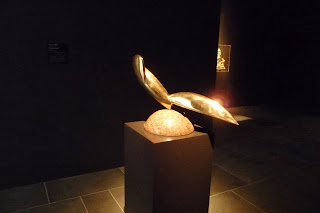Adelaide Art Gallery
I am not one of those that think Art Galleries, Museums or
Libraries are places only to visit on rainy days. I love them and have great
difficulty passing one by without popping in and seeing what they have to
offer.
I kept the Adelaide one until I had a whole afternoon, so
that I could do it Justice.
The Art Gallery of South Australia to give it its correct title
is situated on North Terrace, adjacent to the South Australian Museum and
surrounded on the other side and rear by the University of Adelaide.
The front has a very traditional Portico with 6 supporting
Corinthian columns. The original art gallery was founded in the institute,
together with the Museum and Library. In 1881 the National Art gallery of South
Australia was formed and in 1900 a new wing was built to house the Art gallery,
this was what is today called the Elder Wing. Subsequent additions were needed
as the Gallery out grew its skin. These were done in such away as not to
compromise the external and internal aesthetics of the original design. These
now house the contemporary and traveling collections. The original 2 rooms in
the institute were opened by Prince Albert Victor and Prince George later King
George V.
Right that is enough about the history of the building, it
is now time to walk and talk about the inside and contents. On entering the
building (and handing in your back pack) you walk from room to room, there is
no, classification as such (with the exception of the Aboriginal art and the
traveling exhibitions, but it is well laid out and I think deserves credit
being given to the curators and the director.
There are themes, Metamorphose being a recurring one, see if
you can spot it. So without further ado
we shall go on a wander.
Pictures at this Exhibition.
As described by the gallery
"In the wondrous but macabre beauty of The Gamekeeper’s gibbet, light transforms abstract sculptures into the figurative. Other works relate to the literal interpretation of metamorphosis, involving a complete change of a physical form or substance. Other exhibits explore changes to visual reality. Spiritual transformation and changes in time are also represented."
After the permanent exhibits we descended a level and there to greet us is a colourful dancing Indian Girl. The exhibits are either from the Galleries own acquisitions or are on loan, it is called “Realms of Wonder” and involves itself with the tree major religions of India, Jainism, Hinduism and Islam.
As the gallery describes
"The emphasis on worldly renunciation in the Jain religion inspired calming images of meditating Jinas and delicate hand-drawn illuminated religious manuscripts. With its well-known and iconic images of Siva performing the cosmic dance that balances creation and destruction. Hinduism perhaps most extensively defines the art of India. Muslim artists excelled in the production of decorative arts, and the exhibition features a seventeenth-century inlaid marble panel produced in one of the workshops that decorated the Taj Mahal."
On leaving the Gallery via the back door (this is actually via the café), you enter a grassed square with buildings on two sides, I looked and these seemed vaguely familiar, of course the Barracks in Brisbane. On reading the little tablet with their history, it became clear, these had in fact been the original Police Barracks and the grass square I was standing on was in fact the old Parade Ground.
And that is that dear friends, amongst the exhibits are a Henry Moore and a Hepworth, did you find them?
































No comments:
Post a Comment